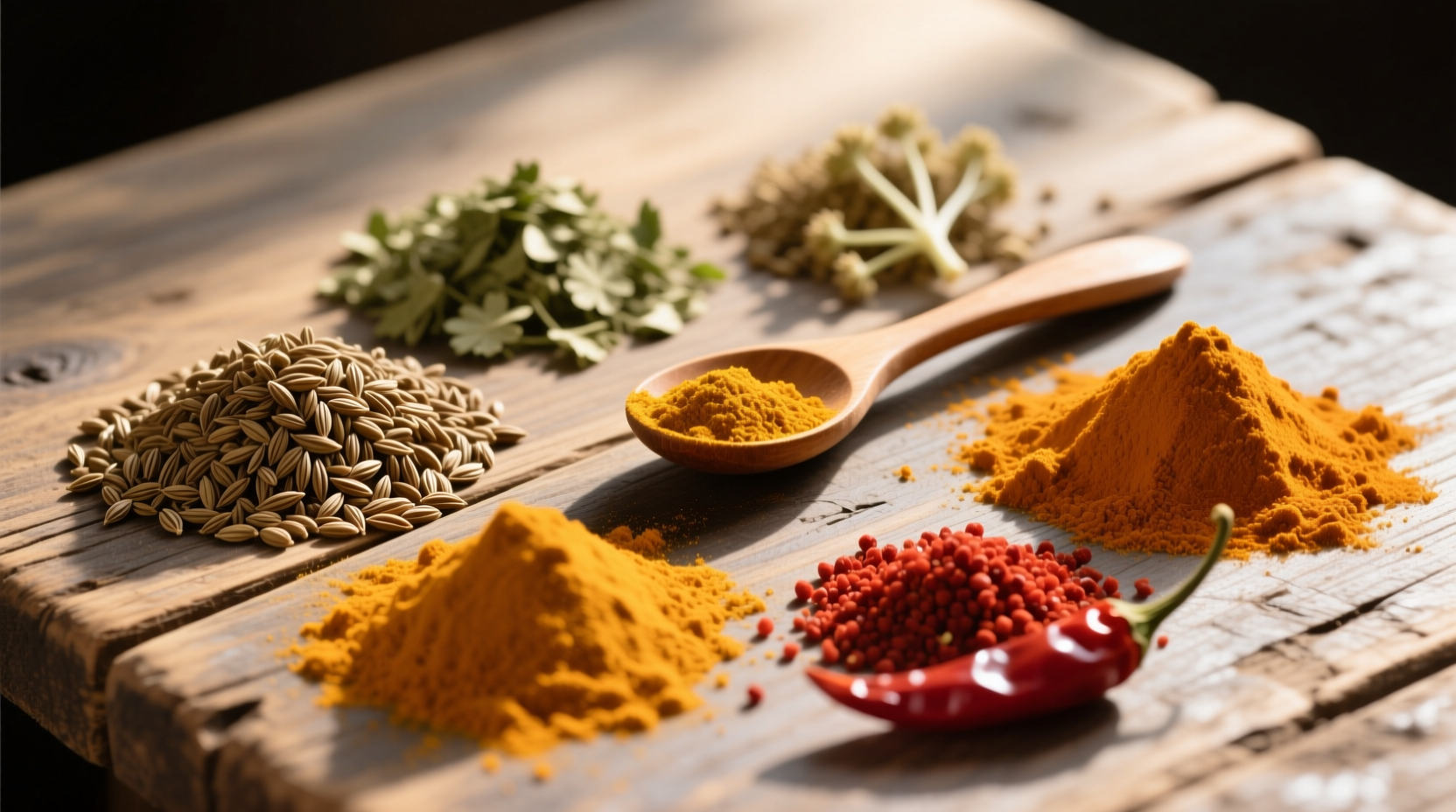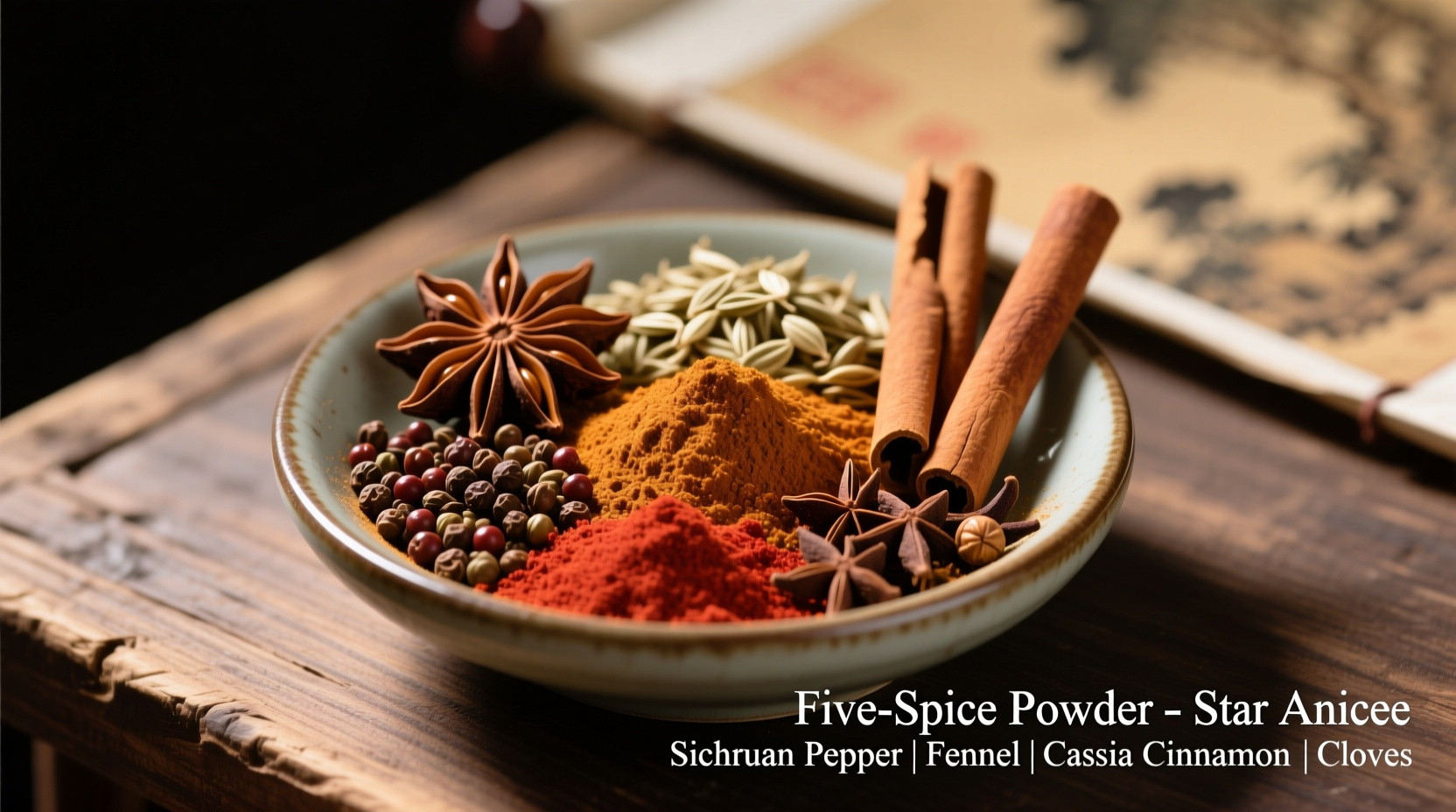Ever wondered what gives Peking duck its distinctive aroma or transforms simple roasted meats into complex culinary experiences? The secret often lies in Chinese five spice powder—a cornerstone of Eastern cooking that's gained global popularity. Understanding its precise composition unlocks authentic flavor replication in your kitchen.
The Core Components of Authentic Five Spice
While regional variations exist, the traditional Chinese five spice formula maintains these five essential ingredients in specific ratios:
| Spice | Flavor Profile | Traditional Proportion |
|---|---|---|
| Star Anise | Sweet licorice-like, warm | 30% |
| Cloves | Intensely aromatic, pungent | 20% |
| Chinese Cinnamon (Cassia) | Spicy-sweet, woody | 20% |
| Sichuan Pepper | Citrusy, numbing sensation | 15% |
| Fennel Seeds | Mild anise, slightly sweet | 15% |
Why These Five Spices Create Culinary Harmony
Unlike Western spice blends focused primarily on heat, Chinese five spice follows wu xing (five elements) philosophy. Each spice corresponds to one of the five fundamental flavors recognized in traditional Chinese medicine:
- Star anise represents sweetness
- Cloves embody bitterness
- Chinese cinnamon delivers sour notes
- Sichuan pepper provides saltiness
- Fennel seeds contribute umami
This balance creates dishes that satisfy multiple taste receptors simultaneously—a principle documented in the Journal of Ethnic Foods as central to Chinese culinary philosophy.

Historical Evolution of Five Spice
The blend's origins trace back to Ming Dynasty (1368-1644) spice merchants who developed standardized formulas for consistent flavor. Historical records from the Chinese National Library show early versions varied significantly by region:
| Era | Common Composition | Primary Use |
|---|---|---|
| Ming Dynasty (14th-17th c.) | Star anise, ginger, licorice, Sichuan pepper, turmeric | Medicinal applications |
| Qing Dynasty (17th-20th c.) | Star anise, cloves, cassia, Sichuan pepper, fennel | Culinary standardization |
| Modern Era | Standardized 5-spice with regional variations | Global culinary adaptation |
Regional Variations You Should Know
While the classic formula remains dominant, regional adaptations reflect local preferences:
- Cantonese version: Higher star anise content (up to 40%) for sweeter profile
- Sichuan variation: Additional dried chilies for pronounced heat
- Taiwanese blend: Includes a touch of white pepper for brightness
- Vietnamese nguị vị: Substitutes fennel with ginger for different flavor balance
These regional differences highlight why authentic Chinese five spice powder shouldn't contain cinnamon (true cinnamon rather than cassia), ginger, or other additives sometimes found in commercial blends.
Practical Applications in Your Kitchen
Understanding what are the spices in 5 spice helps you use it effectively. This blend shines in specific applications while being inappropriate for others:
Best Uses for Five Spice Powder
- Rubbing on fatty meats like pork belly or duck before roasting
- Infusing broths for noodle soups and stews
- Creating marinades for char siu (Chinese BBQ pork)
- Adding depth to braised dishes like red-cooked meats
When to Avoid Five Spice
- Fish and delicate seafood dishes (overpowers subtle flavors)
- Vegetable stir-fries without meat components
- Desserts (except certain Chinese moon cakes)
- Any dish where you want to highlight individual spice notes
Creating Your Own Authentic Blend
Commercial blends often contain fillers or incorrect ratios. Making your own ensures freshness and authenticity:
- Toast whole spices separately in a dry pan until fragrant (1-2 minutes)
- Cool completely before grinding
- Use a 3:2:2:1.5:1.5 ratio of star anise:cloves:cassia:Sichuan pepper:fennel
- Store in an airtight container away from light
For optimal flavor extraction, add five spice early in cooking processes for meats, but later for delicate applications. The volatile oils begin degrading after 6 months, so small-batch preparation yields best results.
Substitutions When You're Missing Ingredients
Ran out of five spice? These substitutions maintain authentic flavor profiles:
- No star anise: Use 1.5x fennel seeds + pinch of anise seed (not identical but closest approximation)
- No Sichuan pepper: Combine black pepper and coriander seeds (1:1 ratio) for similar citrus notes
- Vegetarian version: Omit animal-derived additives sometimes found in commercial blends
- Low-sodium alternative: Five spice naturally contains no salt—perfect for sodium-restricted diets
Common Misconceptions About Five Spice
Several myths persist about this essential Chinese spice blend:
- Myth: Five spice always contains cinnamon
Fact: Authentic blends use Chinese cassia, which has stronger, spicier notes than true cinnamon - Myth: All five spice blends are identical
Fact: Regional variations create distinct flavor profiles across Chinese communities - Myth: Five spice is extremely hot
Fact: The "heat" comes from Sichuan pepper's unique numbing sensation, not capsaicin
Preserving Flavor Integrity
Research from the International Journal of Gastronomy and Food Science shows that improper storage causes 60% flavor degradation in pre-ground spices within 3 months. For optimal results:
- Buy whole spices and grind as needed
- Store in amber glass containers away from heat sources
- Label containers with purchase dates
- Avoid refrigeration (causes moisture absorption)
Conclusion: Mastering Five Spice Fundamentals
Understanding what are the spices in 5 spice powder transforms your approach to Chinese cuisine. This carefully balanced blend of star anise, cloves, Chinese cinnamon, Sichuan pepper, and fennel seeds creates the distinctive flavor profile that defines countless classic dishes. By recognizing regional variations, proper applications, and storage requirements, you can elevate your cooking with authentic results that honor centuries of culinary tradition.
Frequently Asked Questions
What are the five spices in traditional Chinese five spice powder?
The five essential spices are star anise, cloves, Chinese cinnamon (cassia), Sichuan pepper, and fennel seeds. These create the balanced flavor profile that defines authentic Chinese five spice powder.
Can I substitute regular cinnamon for Chinese cinnamon in five spice?
While possible, it's not recommended. Chinese cinnamon (cassia) has a stronger, spicier flavor than true cinnamon. Substituting creates a noticeably different flavor profile that lacks authenticity in traditional Chinese dishes.
Why does my five spice powder taste different from restaurant versions?
Commercial blends often contain fillers or incorrect ratios. Authentic preparation requires toasting whole spices before grinding in precise proportions (30% star anise, 20% cloves, 20% cassia, 15% Sichuan pepper, 15% fennel). Freshness also significantly impacts flavor intensity.
Is Chinese five spice powder gluten-free?
Authentic Chinese five spice powder contains only the five named spices and is naturally gluten-free. However, some commercial blends may include anti-caking agents or be processed in facilities with gluten. Always check labels if you have gluten sensitivity.
How long does homemade five spice powder last?
Properly stored in an airtight container away from light and heat, homemade five spice powder maintains optimal flavor for 6-8 months. After this period, the volatile oils begin degrading, resulting in noticeably diminished flavor intensity.











 浙公网安备
33010002000092号
浙公网安备
33010002000092号 浙B2-20120091-4
浙B2-20120091-4